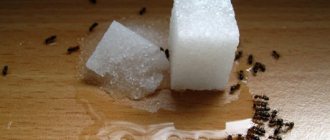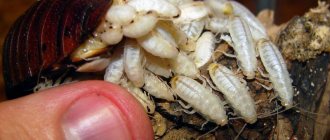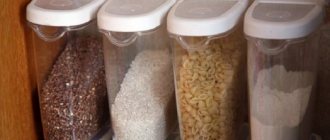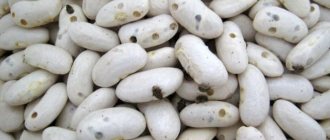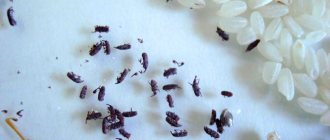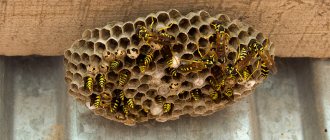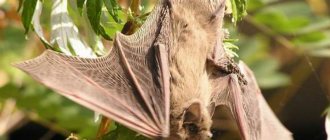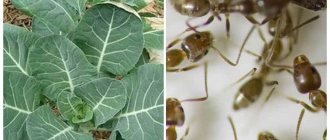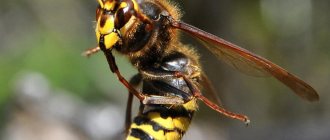When the house is tidy and the kitchen sparkles with cleanliness, this is always a clear sign that the house has clean owners. Beautiful interior decoration and original design only emphasize the status of the inhabitants of the house, but quite often against this rosy background situations arise that literally turn everything upside down. Uninvited guests appeared in the sparkling kitchen, in a room that had recently been renovated. The appearance of pests in your own kitchen can come as a shock to any housewife. Little worms on the beautiful new ceiling, in the kitchen, where?
White worms are a fairly common nuisance in everyday life. Many of us are often taken by surprise by an insect invasion, forcing us to frantically look for a way out of the current situation. We will try to find out who settled on our kitchen ceiling and for what reasons, and what actions need to be taken to successfully combat parasites.
Causes of parasites in the home
In the old days, the presence of parasites in houses and city apartments was quite common. Classic examples are an infestation of cockroaches in the kitchen or bedbugs in the bedroom. Thanks to the invention of new means of combating harmful insects and the use of modern finishing materials, household pests were dealt a crushing blow. The change in the internal microclimate of residential premises played a positive role, which led to the disappearance of favorable conditions for the habitation of annoying “neighbors”.
Currently, such cases have become much less common, but they do occur occasionally. For example, the appearance of white worms on the kitchen ceiling is familiar to many residents of high-rise and private houses. As a rule, this happens so unexpectedly that people are at a loss about the reasons for such a misfortune. The question also arises of what exactly we are dealing with.
Insects of this type independently enter the home from the outside. For this to happen, there must be favorable conditions in the house for their habitat and reproduction. This situation is quite serious and requires an immediate response. Otherwise, all this can lead to the most dire consequences. Usually, in case of delay, in the future you will have to deal with a large number of moving larvae and moths flying everywhere.
Where do they come from?
There can be several options for the appearance of worms of different colors:
- A clothes moth larva (actually a butterfly caterpillar with microscopic limbs). You can usually find them in underwear that has been in the closet for a long time.
- The larvae of the carpet beetle (carpet beetle) are brownish, with protruding fibers.
- The larvae of the beetle grinder (lives in furniture made of wood) are white and quite large. But they can only get into bed by accident and in single quantities.
- Flea larvae are very small and harmless to humans. They are rare.
- Fly larvae (in summer, if there is spoiled food lying around).
Basically, their appearance is random. You can get rid of them by shaking out the contents of the closet, washing them, and using disinfectants (they can be purchased in pharmacies and stores).
If after cleaning the worms appear again, this is a reason to sound the alarm, since you are dealing with pinworms.
White worms on the ceiling in the kitchen - what are they?
The worms on the kitchen ceiling are the larvae of the familiar food moth.
The main danger lies in the short reproduction cycle of this parasite:
- After the adult female lays eggs and the appearance of the larvae, no more than 7-14 days pass.
- The life span of a white larva before turning into a small moth is 40-60 days.
- Once in favorable conditions, food moths begin a wave-like reproduction process that is difficult to interrupt. Conditions for the spread of insects are created by apartment residents without even knowing it.
The main danger comes from the larvae. An adult moth lives no more than 5-7 days and does not cause much harm. She even lacks an organ for eating. At the same time, food moths lay their eggs in food products, thereby providing food for the future generation of parasites. The number of eggs laid at one time can number several hundred. If the surrounding atmosphere is acceptable, they are almost immediately ready to turn into a whole colony of larvae.
The most comfortable living conditions for food moths:
- Air temperature from +23.
- Humidity – 45-50%.
A warm place with plenty of food is the ideal environment for white worms to breed quickly on your kitchen ceiling. Females most often lay eggs on shelves and in cabinets in the kitchen. This is where, as a rule, stocks of porridge, cereals and dry semi-finished products are located. Only 7-14 years will pass, and a huge mass of larvae hatched from eggs will begin to feed on edible bulk and dry foods.
Studies have shown that a colony of 500 larvae can spoil up to 100 kg of food. The waste products secreted by parasites contaminate cereals or porridges, making them completely unsuitable for consumption. Therefore, you should not be careless about moths flying in the kitchen. Otherwise, very little time will pass, and numerous worms will appear on the ceiling.
Preventive measures
It is difficult to protect yourself from the larvae that you can bring from the store any day, but certain measures will help avoid problems.
It is better to store bulk products in tightly closed jars rather than in plastic bags - this way worms will not be able to crawl from container to container. You should not make large reserves. As often as possible, sort out the dishes and bags in the kitchen cabinets, wash the shelves, and lay out bunches of herbs. For example, in a Provence-style kitchen, bundles of dried lavender would be very appropriate and in a prominent place. Protect yourself and the worms on the ceiling won't bother you. Special containers for storing bulk products - transparent, tightly closed
No one is immune from the appearance of food moths, so be vigilant when choosing products, keep the kitchen clean and quickly respond to the first signs of infestation.
Why does food moth appear and what does it mean?
Adult moths are small moths measuring 8-10 mm. Most often we encounter moths of gray and brownish-yellow color. It may seem that such a small insect does not pose any particular danger to humans, but this impression is deceptive. The consequences can be the most unpredictable and unpleasant. After an expensive repair, it is very unpleasant to see caterpillars on the ceiling in an apartment. To remove them, you will need to dismantle the ceiling system, followed by thorough cleaning and disinfection of the entire base. This applies to corners, ceilings and frame structures. Ceiling screed is more convenient in this regard, because... has no hidden cavities.
White worms on the ceiling are the result of food moths in the home. It will not be able to start in the house on its own. As a rule, it is brought in along with low-quality food products by the owners themselves. The store or market is full of moth-infested products, which are very difficult to identify. First of all, this applies to porridge, flour and other bulk semi-finished products. According to the rules, they must undergo mandatory fumigation during storage. However, in practice, this condition is often ignored by unscrupulous suppliers and food manufacturers. After packaging, such goods end up on store shelves.
After contaminated products enter the kitchen or other warm room, the above-described process of ripening of eggs and larvae begins. Caterpillars quickly turn into pupae and then into butterflies that can lay new eggs. Worms crawling on the kitchen ceiling are the final stage. Ceilings are very convenient for parasites to live in, because... This is where the air is warmest and most humid. In addition, this surface is the least likely to be cleaned for obvious reasons.
It is on ceilings that the transformation of larvae into pupae most often occurs. The reason why white worms appear on the ceiling is an instinct that makes them crawl up the walls and kitchen furniture. They look for the quietest and most secluded place, finding it on the ceiling base. In this case, the material used to make the ceiling is practically irrelevant. It can be plastic, stretch fabric, wooden lining, various panels.
It is important to keep in mind the omnivorousness and gluttony of food moth larvae. They are able to chew through bags and bags of food, looking for suitable food for themselves. After the caterpillars die off and their metabolic products pollute the inhabited kitchen space. Products contaminated in this way should be thrown away immediately.
Types of silverfish: what “enemy” you have to deal with
Silverfish in an apartment is the result of unsanitary conditions
Appearance of “lovers” of humid climates
The insect's body length can reach 1.9 cm, it is flat, tapering from head to tail. The silverfish got its name from the silvery scales with which it is covered. From the head, two whiskers are directed forward, three similar tails are directed behind, there are no wings. The eyes are compounded, with color vision that perceives ultraviolet light.
The common silverfish, or as it is also called, the sugar fish, moves very quickly along the floor, ceiling, can run into a narrow crack, hide in a hole, and all this with the help of three pairs of legs with tenacious claws. Such organs of movement make it difficult to fight insects, since seeing does not mean catching, and they hide perfectly.
If you look closely, you can catch the resemblance to a fish fry, for which the British call it silverfish. Scientists have counted almost 600 species of silverfish in nature, 10 of which live in Russia. But only two apartments are besieged by silverfish and house thermobia.
Places of deployment and diet
Knowing the “habits” of insects makes it easier to find and destroy them. Most of all, they like to hide in damp places, where they can profit from something. They eat quite a varied diet. Paper, wallpaper, books, bulk products (flour, pasta, cereals), animal feed, cotton and silk items are used. The most unpleasant thing is that the lack of food does not frighten them; in favorable living conditions, they can live for about a year without food at all, and with good nutrition they can live for five years.
Determining whether there is a silverfish in an apartment or not is sometimes difficult, since the insect prefers a nocturnal lifestyle. First of all, where it can be found - places with humid air, condensation, water. These are bathrooms, toilets, shower boxes, and other places that are often closed during renovation, creating an aesthetic appearance - sewer pipes and cold water pipes located in hard-to-reach places, for example, under the bathtub.
How to fight parasites
The appearance of caterpillars on the ceiling is a fairly common problem, which explains the fairly large number of household pest control products. To get rid of food moths, you can use folk or factory methods. An integrated approach is most effective.
All known methods of fighting moths can be divided into the following groups:
- Prevention.
- Destruction by physical and mechanical impact.
- Chemicals.
Appearance and description
The food moth is a small insect similar to a moth. Its size does not exceed 1 cm, the color is inconspicuous, brownish-gray. Wings with a pearlescent tint and a pattern of dots and stripes. Thanks to this coloring, moths are difficult to notice in food. The insect is most active in the evening and at night, and during the day it sits on furniture, walls, and cornices.
The female lays more than 100 eggs during her life. Food moth eggs are very small, they are almost impossible to distinguish with the naked eye. Moth larvae emerge from the eggs - small, translucent whitish worms with a dark head. They are the ones who harm supplies.
Appearance
Prevention
This procedure includes the following techniques:
- Remove non-perishable food items from the kitchen. It is best to store cereals and cereals in the pantry or on the balcony. Cold air will stop the larvae from breeding. In cases where products of this type show signs of contamination, they must be treated thermally. The easiest option is to bake them in the oven.
- Do not store flour, sugar and cereals in large quantities in a room not equipped for this purpose. It is recommended to buy such products in small quantities that will be used up quickly.
- To increase the effectiveness of preventive measures, it is recommended to use proven traditional methods. As experts say, food moths do not tolerate sharp and pungent odors. To scare it away, place dried wormwood, mint or geranium inside kitchen cabinets.
- Another folk method is to use various spices (cloves, bay leaves or allspice) to fight moths. They are laid out in rag bags on grocery shelves.
However, you should not limit yourself only to folk methods, because they do not always bring the desired effect in the fight against worms on the ceiling.
Preventive measures
Preventive measures that will help prevent the appearance of food moths at home:
regularly check the condition of bulk products and dried fruits; keep kitchen cabinets clean; If possible, carefully inspect cereals, pasta, and dried fruits before purchasing (pay special attention to products sold at discounted promotional prices); store food correctly, bringing it home and immediately pour it from bags into jars or containers; to reduce humidity in kitchen cabinets, place a cup of salt inside; ventilate the kitchen as often as possible; Use food moth repellents in the kitchen.
Before storing purchased cereals, flour or grains, you can heat them in a frying pan or in the oven.
How to deal with worms
Larvae on the ceiling are a sign of a serious stage of parasite infestation in your home. This suggests that certain consequences cannot be avoided. Specialized stores offer a large number of fairly effective means of combating food moths and their larvae. To achieve an acceptable result, it is advisable to combine several methods: parasites sometimes adapt to the components of one product, and they no longer harm them.
An integrated approach involves the following procedure:
- Inspection of the kitchen area, including pantry, cabinets and mezzanines. The purpose of this event is to discover the habitat and breeding place of parasites.
- Carry out mechanical cleaning of the premises. It must be accompanied by physical destruction of the larvae. This method of moth control is the most effective.
- Wash kitchen cabinets, ceiling trim, panels, shelves, and cornices with special products. Dishwashing gel and a soft sponge are suitable for this. When cleaning ceiling trim, it is necessary to take into account the degree of moisture resistance of the material.
- Carry out heat treatment of the dishes where the spoiled products were located: to do this, they are scalded with boiling water. After this, they need to be washed using laundry soap and vinegar. These simple remedies, available in every home, pose a great danger to food moths and their larvae.
Chemical compositions for combating food moths are sold in the form of aerosol cans. We are most often talking about insecticides, which are poison for moth larvae. After contact with the substance, the insects quickly die: in this way the entire colony can be destroyed. When using this very effective remedy against moths on the ceiling, you must wear a respirator and protective clothing.
Before starting chemical treatment, it is imperative to remove all products from the kitchen. It is recommended not to use a kitchen treated with aerosols for 24 hours. After waiting for this pause, they thoroughly clean all surfaces of the room, washing off the remnants of the toxic substance and sweeping away insect corpses. The cleaned room must be thoroughly ventilated, because... Inhalation of product residues may lead to deterioration of health.
In addition to chemicals, effective moth traps are available on the market. Their task is to disorient adult individuals and create serious obstacles to their further reproduction. Models of such devices vary, so you should carefully read the instructions before use.
Clothes (linen) louse
Body lice (also known as linen or scabies) lice infest in old, unwashed clothes or bedding. They hide in the fabric and then bite a person at night if they are close to him. It is possible that they may well live in sofa upholstery, penetrating deeply into its structure. This is why fogging or spraying with a deep-penetrating insecticide is the most effective way to get rid of these insects. Linen louse activity is observed at night; they are invisible during the day. The body is smooth, ranging in size from 2 to 5 mm, has antennae, and the color of the body changes depending on blood saturation. A hungry louse is light and translucent yellowish, while a well-fed louse has a dark dot on its abdomen.
Where do they come from? It’s very simple - they are brought into the house with the things of an infected person or when such a person sits on your sofa for a while. Therefore, you need to be more careful when inviting certain disadvantaged people who clearly do not like to take care of themselves, their bodies and clothes. You can bring a louse into the house on your clothes. When you sat next to an infected person somewhere. This is not necessarily close communication with homeless people, but you can pick up such a “little animal” even on public transport, trying on clothes in a store, vacationing in cheap hotels and other situations.
Fighting methods:
- Boil clothes more often when washing, or wash in a mode where there is hot water in the washing machine. Woolen items should be dried properly to prevent shrinkage.
- You can add vinegar to the wash, which softens not only the integument of adults, but also nits.
- It will be useful to take the sofa out into the sun or frost.
- Even ironing a sofa with a steaming iron, if it has fabric upholstery, can easily destroy a good part of the lice. Vinegar is also added to the water in the iron.
- Especially when steaming a sofa, you should repeatedly go over the seams of the upholstery, where larvae and lice can get clogged.
- Treat with any preparation that destroys lice. Eg. Karbofos or a composition such as a mixture of kerosene and soap solution.
Karbofos
- Published by Russia.
- Available in powder or emulsion.
- Contains malathion.
- Affects a large number of different pests.
- Toxicity is high.
- Re-treatment is required after 3-4 weeks.
- The average price is 40-80 rubles per powder, emulsion 5 liters - 3150 rubles.
BUY
Medilis-Super
- Production - Russia.
- Format – concentrate.
- The volume of the can is 500 ml.
- Active components – fenthion (24%).
- Preparation of working solution: 9 ml per liter of water. Bed linen is soaked in this solution for 20 minutes; when irrigating clothes and sofas, this should be done on both sides
- Toxicity class 4.
- The average price for an aerosol can is 1,500 rubles.
BUY
Results
Despite the ugliness of the situation with worms on the kitchen ceiling, it does not pose a particular danger to human life and health. The appearance of parasites has rather moral and aesthetic consequences: this is especially true for squeamish people. No one likes larvae crawling on the ceiling or moths flying in large numbers. The sooner the fight against a detected infection is started, the less time and effort it will take.
The main task is to find the habitat of the parasite colony.
As practice shows, first of all it is necessary to carefully inspect bags or bags of bulk products. It is best to immediately throw away a discovered package containing contamination outside the house. If the larvae and moths have already spread sufficiently throughout the home, general cleaning and the use of chemical agents (aerosols) will be required. However, it is best not to resort to extreme methods. Among the most effective preventive methods is the constant maintenance of cleanliness and order in dry food storage areas. Aromatic herbs and spices, the smell of which cannot be tolerated by moths, are helpful when placed in the pantry or cabinets. When purchasing cereals, pasta, sugar and other bulk products, you must carefully check their expiration date and the integrity of the packaging.
Biological portrait of the offender
Don’t be surprised if, after one white worm, a whole colony of moving larvae settles right in the center of the kitchen ceiling. The fact is that food moths have a short reproduction cycle. It travels from a small egg to an adult capable of reproduction in 6-8 weeks. She especially likes the warm and humid kitchen climate, where the air temperature reaches + 23-25˚С and humidity – 45-50%.
Adults do not have a digestive system; they do not even have a developed oral organ, so butterflies do not feed at all. Transforming from a pupa into a butterfly, insects live for about a week, managing to mate and lay 1-2 hundred eggs in this short period. Cunning pests lay their eggs in deposits of groceries, which are used to prepare our favorite side dishes and cereals. Unlike their “parents,” the larvae are very gluttonous and process any dry food that comes their way.
Typically, small insects can be found in the habitat of their larvae - near grocery cabinets, boxes with supplies, cans of cereals and dried fruits. The feeding environment for food moths guarantees numerous offspring with excellent appetite.
An adult is a butterfly up to 10 mm in length, which has gray, brown-pink or yellowish wings.
How worms get into the house
It is logical to assume that a flying insect flies into the apartment through a window, door or ventilation shaft from not very neat and clean neighbors. This option is possible, but rarely occurs in practice. Much more often, larvae enter the house in food packaging - bags of bulk products, packets of flour, boxes of sugar.
Products become contaminated by careless manufacturers and suppliers during long-term storage, transportation, or even during improper processing. Finding themselves in the comfortable environment of a warm apartment, the larvae turn into butterflies, the adults lay eggs, thus starting the cycle, and as a result - white worms on the ceiling.
Remember that the “ceiling” stage is already a disaster. You will have to spend a lot of time, effort and nerves to clean out your kitchen cabinets and regain their former peace.
Sweets are the favorite food of food moth larvae
Why do they live on the ceiling?
Agree that worms on the ceiling in an apartment are a rather strange picture. Usually we are used to seeing them in the soil, in the grass, under snags or stones, and if in the house, then always in some distant damp corner. But food larvae prefer warmth, dryness and a large selection of tasty foods:
- bakery products;
- sugar and sweet dried fruits;
- various cereals;
- flour,
- nuts.
Why do lazy, comfort-loving larvae suddenly start traveling along the walls and end up on the ceiling?
It turns out that the worms in the kitchen on the ceiling are preparing for metamorphosis - turning into a pupa. Instinct drives sedentary and light-fearing insects out of dark, nourishing corners and forces them to move upward. Fat larvae, ready to pupate, move in groups along the walls and freeze only at the highest point - right in the center of your exquisite, expensive, glossy suspended ceiling.
Many worms die along the way, leaving feces, skins and grayish remains as a souvenir, but a dozen out of a couple of hundred always reach the top. To ensure that the aesthetic appeal of the kitchen interior does not suffer, and your appetite remains as wonderful, it is necessary to quickly respond to the emerging threat.
Cereals in plastic bags are a favorite habitat for kitchen worms
This is interesting: How to seal a hole in the ceiling - how to cover a hole near a pipe, sealing a hole, how to cover a large hole
Measures to “clean up” the territory
Constantly scrubbing a bathroom down to the last square millimeter is difficult, but it is possible to apply basic preventive measures . Instructions for keeping dry are as follows:
- reduce humidity - eliminate leaking taps, ensure good ventilation;
- cover the ventilation holes with fine mesh;
- seal cracks in walls, floors, and ceilings;
- use floor mats made of special materials - rubber, silicone, fiber polymers, bamboo;
- do not create deposits of dirty laundry;
- wipe surfaces weekly with chlorine-containing preparations;
- After general cleaning, thoroughly dry the room using a fan or household dehumidifier.
Desiccant with tablets
By using replaceable absorbent tablets/granules, you will save electricity. One tablet weighing 450 g is enough for a year.
Chemicals
After eliminating the causes of dampness, insecticides will become powerful means of exterminating pests in the bathroom.:
A guaranteed result is provided by professional disinfestation of the premises performed by special services, no matter what its price.
Several types of processing are used:
- cold fog;
- barrier protection;
- hot fog;
- complex.

